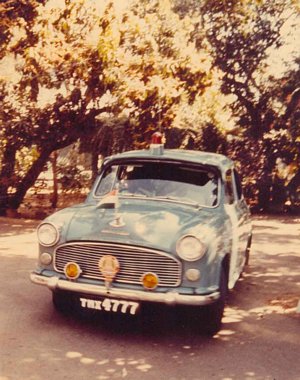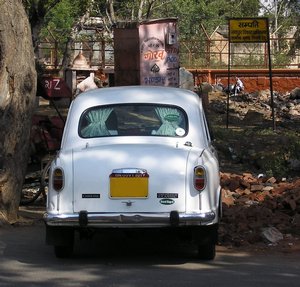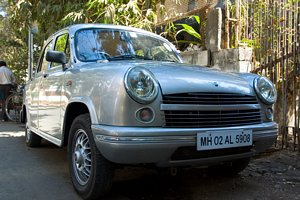















Hindustan Ambassador |
|---|
|
| Topic Navigation |
|---|
|
Wikipedia: Hindustan Ambassador
Page Sections History Photographs Article Index |
History
The following section is an excerpt from Wikipedia's Hindustan Ambassador page on 9 September 2016, text available via the Creative Commons Attribution-ShareAlike 3.0 Unported License.
The Hindustan Ambassador was an automobile manufactured by Hindustan Motors of India. It was in production from 1958 to 2014 with few improvements and changes over its production lifetime. The Ambassador is based on the Morris Oxford series III model, first made by Morris Motors Limited at Cowley, Oxford in the United Kingdom from 1956 to 1959.
Modelled after the British Morris Oxford, the Ambassador was the first car to be made in India and was once a status symbol, but began losing its dominance in the mid-1980s when Maruti Suzuki introduced its low-priced 800 hatchback. It lost further cachet and market share when global automakers began setting up shop in India in the mid-1990s, offering models with contemporary designs and technology. The Ambassador has remained the choice of a dwindling share of bureaucrats and politicians, usually in white with a red beacon on top and a chauffeur at the wheel. It is also still in use as a taxi in some Indian cities.
Despite its British origins, the Ambassador is considered as a definitive Indian car and is fondly called the "king of Indian roads". The automobile was manufactured by Hindustan Motors at its Uttarpara plant near Kolkata, West Bengal. The car was an inspiration of six Indian engineers including Mr. Jaishankar Tewari.
History
When the Birlas wanted a new model to replace their already old Hindustan models based on the Morris Oxford Series Il (Hindustan Landmaster), they scouted for the new Morris Oxford Series III. The car initially came with a side-valve engine but was later improved to an overhead-valve engine. Also the car at that point was quite an innovation with a fully enclosed monocoque chassis, which is why it is spacious inside.
Hindustan Motors Limited (HM), India's pioneering automobile manufacturing company and flagship company of the C.K. Birla Group, was established just before Indian independence, in 1942 by B.M. Birla. They began operations in a small assembly plant in Port Okha near Gujarat by assembling the then Morris 10 as the Hindustan 10. The Morris MO Series models (the earlier one and its next model with a new front grille) were by 1949 introduced, as the Hindustan 14. The production continued till 1954, after which the Landmaster based on the Morris Oxford Series II was introduced, with the same 1476 cc side valve engine, drawn from the earlier Hindustan 14.The same engine was used for the older Ambassadors Mark I from 1958 till 1960.
The car was briefly imported to the United Kingdom in 1993 (as the Fullbore Mark 10). The cars were retrofitted with a heater and seat belts in order to comply with European safety legislation, but only a tiny number were ever sold, and the importer went into liquidation.
Production of Hindustan Ambassador at its plant outside the city of Kolkata was ended due to weak demand and financing problems. Prior to the cancellation, the company had sold 2,200 Ambassadors in the financial year which ended in March 2014.
Evolution
The Ambassador has been in continuous production since its inception, with very few improvements or changes.
In 1948, Hindustan Motors shifted its assembly plant from Port Okha in Gujarat to Uttarpara in West Bengal's Hooghly district and strengthened its manufacturing capacity in the automobile segment.
The 1954 Morris Oxford series II in India was licence-built at Uttarpara, (Hooghly dist.), West Bengal, three years after its debut in England and labelled as the 1957 Hindustan Landmaster.
Engaged in the manufacture of the Ambassador, Contessa and utility vehicles like the Trekker, Porter and Pushpak, the plant also has to its credit many innovations and improvements in the automobile industry in India. Hindustan Motors is the only manufacturing facility in the world to manufacture parts for Bedford trucks currently.
Sale of Ambassador taxis had been banned since 1 April 2011, a year after BS IV emission standards were rolled out in 11 Indian cities, including Kolkata. At present the company is in an extremely challenging situation with plummeting sales and loss of Rs 29.96 crore in 2011-12. The company could only sell around 2,500 cars in 2011.
However, Hindustan Motors have recently started to fit the cars with a new, cleaner diesel engine, that complies with the new emission rules; and has now been able to resume taxi service in cities such as Kolkata, one of the cities in which it was banned. The Hindustan Ambassador is, once again, a familiar sight on India's roads . The company had stopped paying wages to workers a few months back and has finally stopped production on 25 May 2014.
 |
Photo by "Kumarrajendran" Once used by M. G. Ramachandran View photo of Hindustan Ambassador - 91KB |
 |
Classic 1500 DSL Photo by Mia Bruksman View photo of Hindustan Ambassador - 345KB |
 |
Avigo Photo by "Spinetrak" View photo of Hindustan Ambassador - 204KB |
| Date | Article | Author/Source |
|---|---|---|
| 19 April 2010 | India's Automotive Ambassador Refuses to Yield the Road   | Steve Herman |
| 30 May 2014 | Production of India’s Iconic Ambassador Car Halted  | Anjana Pasricha, VOA News |
